A Long Time Ago... #5
Hello there.
Welcome to the fifth of these posts exploring art, fiction and history. Every other Sunday I share some insights into my two major passions - Star Wars and history, or specifically, ancient art.
Art as a means of representation, observation and meaning, has survived tens of thousands of years, expressed now in a mesmerising multitude of ways. I'm fascinated by its origins, and a particular subgenre of art known as the Star Wars franchise.
At the moment, I’m expressing and sharing this fascination by taking you through my timeline-ordered shelves of Star Wars books, as well as the ancient art sites that inspire(d) my writing.
In A Galaxy Far, Far Away…

At this point in the timeline, we’re much closer to the Original Trilogy films, about five years off, which means the Empire has been ruling for fourteen years, and a Rebellion needs to begin.
Which brings us to the many books adapting and spinning off from the animated show Star Wars Rebels, a series showing the journey of one little family-unit rebel cell as they join larger groups of rebels and go up against larger foes, until a year before Episode IV: A New Hope. (That’s very much an oversimplification - I’d really recommend watching the four-season journey of the show.)
Rebels was the first new on-screen Star Wars after Disney purchased Lucasfilm, and so there were many tie-in projects to its first season. I have all those little books interspersed in chronological order on the left there, but for ease here I’m going to break them down into series.
Servants of the Empire is a four-volume series of junior novels from author Jason Fry. They’re a piece of tie-in media that actually makes the original show’s characters feel like they’re the tie in to the book as you’re reading it. The books have some of the best examples of the sheer cruelty of the Empire, and how people can be so blind to it. We follow Zare Leonis, a character recurring in a few episodes of Rebels, but completely fleshed out here. The books explore how he joined the Empire and his hunt for his sister that disappeared when she enlisted. With a whole cast of great supporting characters, it also fleshes out Lothal where the animated show is based, and ties into many more Star Wars projects beyond Rebels’s first season.
Ezra’s Gamble by Ryder Windham is (like the first volume of Servants of the Empire) set before the start of Rebels, following the show’s protagonist Ezra on a fun standalone junior novel adventure, teaming up with famous lizard-like bounty hunter Bossk (first seen in Episode V: The Empire Strikes Back). The book ends by adapting one of four little animated shorts set just before Rebels, so leads seamlessly into the next books.
The Star Wars Rebels chapter books are adaptations of the first season of the animated series, all written by Michael Kogge. It means that you can get a whole expanded experience of Rebels season one just by reading all these quick little books, setting the scene for longer novels that connect to the show later in the timeline. The first book adapts the prequel shorts, while the rest speed through the film-length pilot episode and the important beats of season one.
The Rebellion Begins is a much longer and more in-depth adaptation of the film-length first episode of Rebels’s first season with multiple POVs and some expanded scenes I think, again by Kogge.
Leia, Princess of Alderaan by Claudia Gray focusses on the eponymous character at the age of sixteen, and how she uncovers and joins her parents’ rebellious activity. (We all know how it ends in A New Hope, right?) It’s so cleverly done, as everything both good and bad that happens to Leia in this book is overshadowed by the fate of her homeworld. The book also includes many characters from previous Star Wars films, especially showing us the start of Leia’s friendship with Amilyn Holdo, portrayed by Laura Dern in Episode VII: The Last Jedi. I would say it’s the best book about the character, as it captures her journey into the wider worlds perfectly, and yet there’s a later novel also by Gray that in my opinion does even more exciting things with Leia.
And now we get to Timothy Zahn’s first canon Thrawn trilogy, a somewhat official/unofficial trilogy as each book really tells its own story. The first book, just named after the character, takes on the journey from Thrawn first finds the Empire all the way to his Grand Admiral status and assignment to foil the rebels of… Rebels, in that show’s third season. Zahn seemingly effortlessly charts about thirteen years of story and rising the ranks, also introducing new characters (primarily Thrawn’s aide Eli Vanto) and perfectly fleshing out Rebels’s second season 3 villain Governor Pryce. I don’t know what more I can say other than this is basically required reading. An author at the top of their game with a character they created, pitting him against a perfect enemy and the struggles of being an alien amongst an Imperial Navy of humans.
Thrawn: Alliances picks up right after Rebels Season 3, following Thrawn as he’s sent on a mission by the Emperor to investigate a disturbance in the Force. Oh, and he’s partnered with Darth Vader. That alone would be a great book, but the novel constantly switches back to ‘Then’ chapters, in which Thrawn teams up with Anakin Skywalker in the time of the Clone Wars. That is also a great story in its own right, one that explains Thrawn’s knowledge of the Jedi in the first Thrawn book, and of course is later so cleverly tied into Thrawn’s explorations outside his home region of space in the Ascendency trilogy earlier in the timeline. It’s as much an exploration of Anakin/Vader as Thrawn too, also featuring Padme as a POV character in the ‘Then’ story.
Thrawn: Treason somewhat ties all of the previous five (earlier in the timeline) Thrawn stories, with the threat and allies from the Ascendency trilogy, the lessons and characters and allegiances set up in Thrawn, and also fitting neatly with Thrawn’s few-episode absence in Rebels’s fourth and final season. Not only that, but it introduces new characters and (treasonous) politics within the Empire, and ties into Rogue One with Krennic’s Death Star project. Rogue One’s tie-in books and other stories set around the Original Trilogy will be next time’s Galaxy Far, Far Away… section.
In Pintures River Canyon, Santa Cruz Province, Argentina…
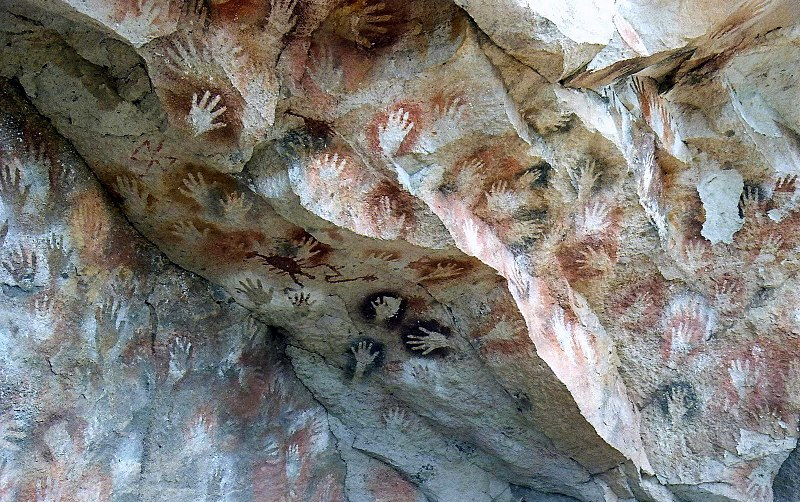
This site is very much a case of images speak louder than words. Luckily, I can present you with both. Here’s how I originally described the Cueva de las Manos, the Cave of the Hands, at the start of one of my short stories. The idea of handprints being initiation at this site was a theory I picked up somewhere along the way.
In the middle of an arid, rocky canyon, runs a band of green.
Waving to it are hundreds of burning hands, painted as prints or negatives covering every centimetre of beige surface at one point in the canyon wall. These many hands, in red, yellow, green, black and white, made as an initiation, touching the beyond before entering the dark unknown portal, guard the entrance to the cave tunnel, a place between this world and the underworld, the world of spirit-visions.
The many hands are a fire-collage of fingers, all reaching up and up like overlapping, licking flames, an inferno of past-life-imprints.
I’ve actually talked about this site a lot for various non-fiction things, as well as a short story focussing on the hunters painted within. Humans tend to show up a lot less in prehistoric art from tens of thousands of years ago, but this cave was decorated between 7,300 BCE and 700 CE (calculated from the remains of bone pipe used to spray the many negative handprints), which to me seems like an incredible span of time. I think that’s probably due to the relative recency of 700 CE, as there are sites of course spanning tens of thousands of years of use…
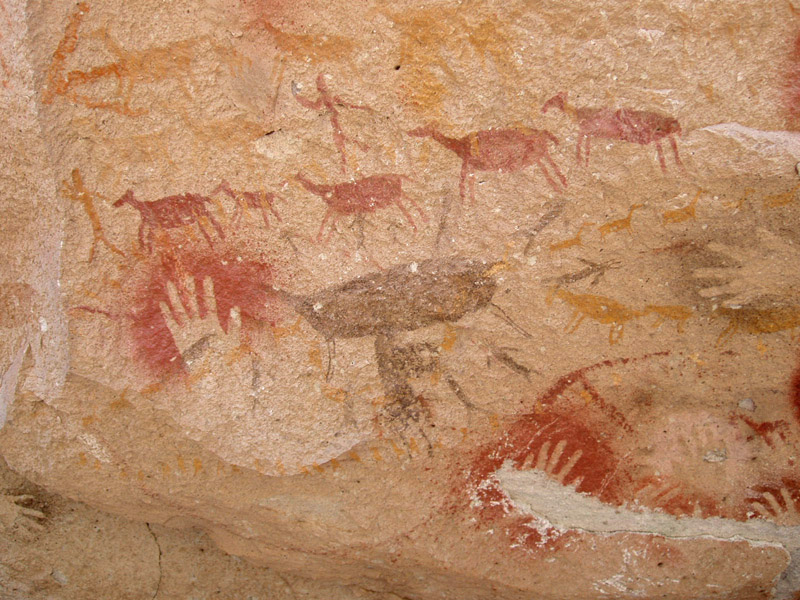
This amazing overlay of scenes and hands showcases some different interactions between humans and animals, mainly hundreds of guanacos, similar to a wild llama, painted across the centuries. In the cave, hunters are shown with spears, darts, and bolas - cords with weights on both ends.
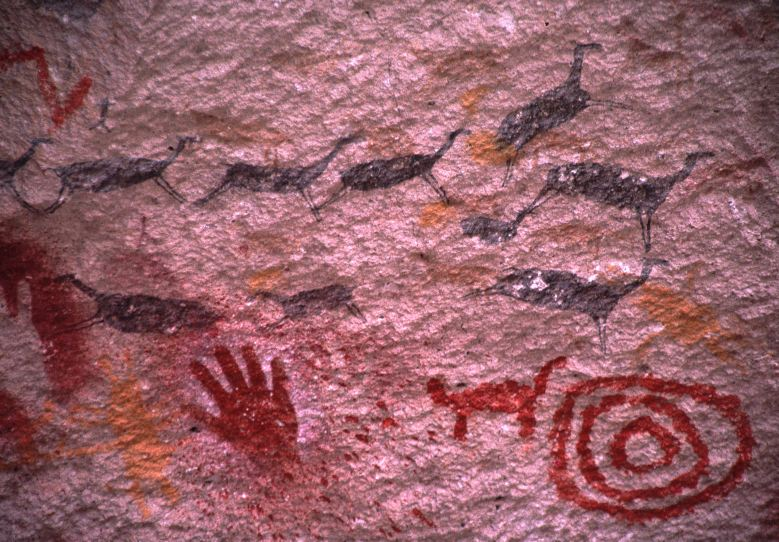
As well as humans and an abundance of guanacos, there’s a few rhea, deer, big cats, lizards and various zoomorphic creatures, perhaps hybrids yet undefined. There’s also geometric forms, circles and sun depictions, as well as lines of dots and zigzags.
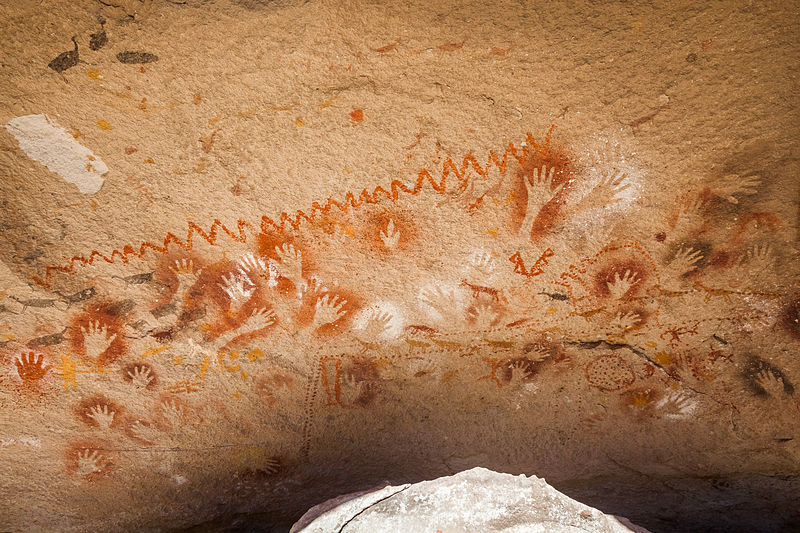
I just think there’s something hypnotic about the display, perhaps actually due to the shamanistic ceremonies that may have been behind the art. But did you notice the rhea print amongst the human hands? It’s pretty close to the centre of the image, below the rightmost third of zigzag, one of a few three-toed negative paintings that seems so special to me, that perhaps they revered the animal enough to add its ‘hand’ to the collage. Of course, there’s a question of whether the bird was alive at the time… Either way, the photo above has examples of art from perhaps all four of the stylistic groups found in the cave over its 8000 years of use.
The first period of artistic endeavour consists of the more naturalistic hunting scenes. These first artists used the topography of the cave wall to represent the features of the landscape important to hunting like ravines. Their scenes of long herds of guanacos and surround hunting tactics can be further classified into five different instances because of the different poly- or monochrome makeup of the scenes.
The second style comes in after a period of absence, a new people that used the cave from 5000 to 1,300 BCE. Their guanacos have noticeably larger bellies, and of course thousands of handprints come from this long stretch of time.
The third style is a continuation of before, but the artwork became more stylised, animal forms becoming more schematic and with more dotted patterns added to displays.
The fourth style is from the 700 CE period, mostly red and continuing the stylised thread of stick figure silhouettes as far as I can tell, people with big drawn on fingers and feet and jagged representations of lizards. This is when more of the abstract geometric art was done too. And yet they still continued the handprint tradition, adding to the tapestry of their ancient ancestors. I wonder if they had any sense of how long ago the first prints were done. It would be like us continually adding new rocks to Stonehenge. Not a bad idea?
The site was fully open to the public for a while in the incredible rock valley landscape (the big archaeological investigation there started in the 60s), but has since been closed off due to people adding their own modern ‘art’ to the tapestry or trying to take flaking pieces of painted rockface with them. I do think tours still run, in some form. One day I’d love to visit, to see with my own eyes a hundred times more handprints than I ever have in a French cave, to stand before that dazzling inferno, an eternal bonfire flame added to by people for thousands of years.
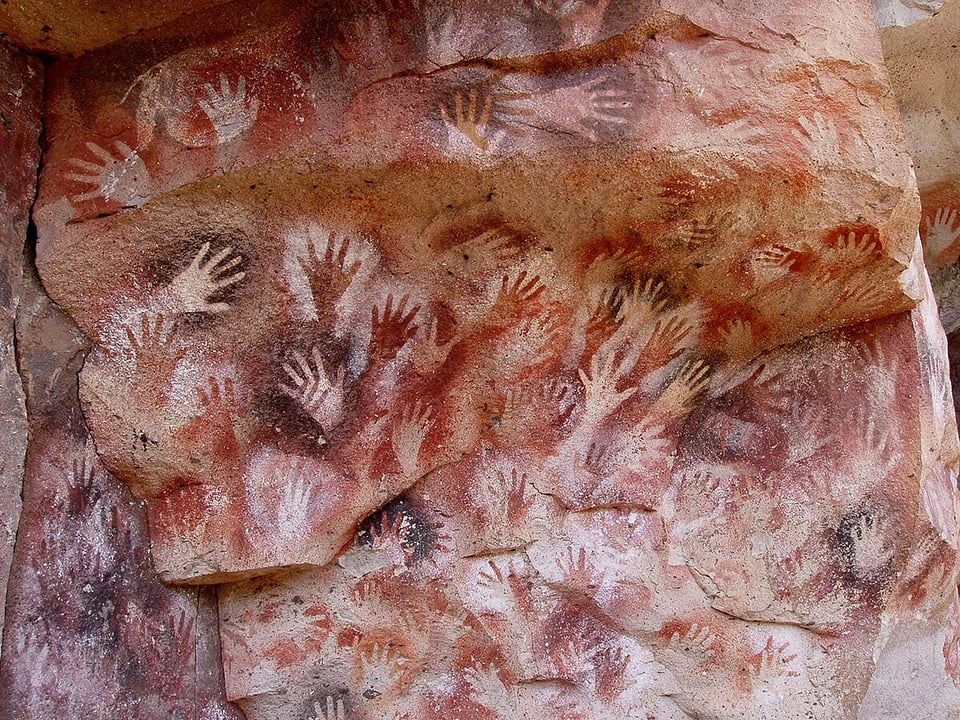
That brings us to an end of this exploration of a long time ago. I hope you enjoyed! I really appreciate the opportunity to sit down and write about these two facets of my reading/writing life, and know that people are reading.
Thank you very much,
Harvey
